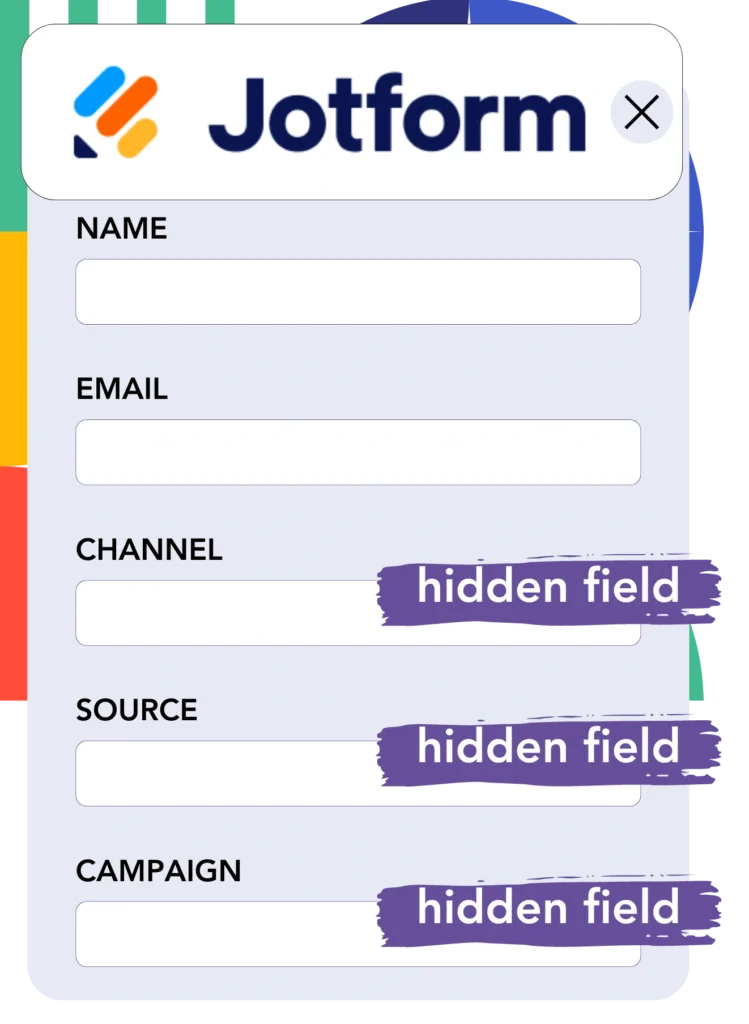Running LinkedIn ads without clear visibility on which ad is responsible for your leads, sales, and revenue can hold back your marketing success.
It’s clear how many leads each LinkedIn ad produced in total, but you don’t have the tools to examine it at the lead level.
Without this information, you are unable to determine which LinkedIn ad drove the leads that converted to customers, limiting your ability to optimize spending.
Leadsources solves this problem.
Your LinkedIn ads data, such as campaign, audience, ad, etc., is captured by Leadsources at the lead level for precise tracking.
You can save comprehensive LinkedIn ad data, including campaign, audience, and ad details, for each lead within Jotform.
These reports, for example, “Ads that generated the most leads,” will assist you in deciding which ad to promote or discontinue.
Let’s dive into it!
Capture LinkedIn ads in Jotform
Step 1: Add Leadsources in the head tag of your website

Sign up to Leadsources.io, and benefit from our 14-day free trial.
Add the Leadsources tracking code to the head tag of your site.
No code is necessary, follow this easy step-by-step guide.
Step 2: Add the UTM parameters to your LinkedIn campaigns

Add the relevant UTM parameters for tracking in all of your LinkedIn ads, including campaign, audience, ad, etc.
As a demonstration, consider utilizing the following UTM parameters in the links of your LinkedIn ads:
- UTM_source
- UTM_campaign
- UTM_term
- UTM_content
Keep in mind that Leadsources tracks lead source data, even when UTM parameters are not present, such as channel, landing page, and landing page subfolder, to offer a complete overview of your leads on a lead level.
Step 3: Add the hidden fields in Jotform

When a user submits your Jotform form, Leadsources ensures that the hidden fields are populated with LinkedIn ads data, such as campaign, audience, ad, etc.
Refer to our detailed guide to integrate hidden fields in Jotform to successfully finalize your setup.
The LinkedIn ads data is captured and saved directly in your Jotform form by Leadsources (refer to Step 4 for further information).
Step 4: Capture the LinkedIn ads data in Jotform

Leadsources captures LinkedIn ad data (campaign, ad set, audience, ad, etc.) whenever a visitor clicks on your LinkedIn ad and visits your website.
Leadsources ensures that the LinkedIn ads data is instantly added to the hidden fields of your Jotform form.
Each time the form is submitted, the LinkedIn ads data, together with the responses from the form, is delivered to the Jotform submissions page for each lead generated.
How does Leadsources work?
Adding the Leadsources tracking code to your site’s head tag allows for the continuous capture of LinkedIn ads data (campaign, audience, ad, etc.) upon each visitor’s arrival.
LinkedIn ads data is stored in the hidden fields of your Jotform form once the data is collected.
The collection of visitor data will be conducted by Leadsources, including the following information:
- Channel
- Source
- Campaign
- Content
- Term
- Landing page
- Landing page subfolder
By utilizing this, you can maintain oversight of important lead source specifics, even when UTM parameters cannot be implemented, as is often the case with organic traffic sources like:
- Google Search
- Instagram bio link
- Social media posts
- Etc.
Although most tools rely on UTM parameters to capture lead information, Leadsources can track your lead source without them.
Therefore, unlike other tools, Leadsources is capable of tracking lead data from all available channels:
- Organic Search
- Paid Search
- Organic Social
- Paid Social
- Referral
- Affiliate
- Display Advertising
- Direct Traffic
This assists you in tracking and bringing all lead source data together in a single central location.
Pro tip:
Track LinkedIn ads in your favorite online form builder, including Cognito Forms, Gravity Forms, Typeform, or WPForms. Using another online form builder? Check our guide on how to track LinkedIn ads in your form.
How to run performance reports
Now that Jotform has your LinkedIn ads data, you can develop performance reports such as:
- Leads per campaign
- Leads per Ad set
- Leads per audience
- Leads per ad
- Etc.
This gives you the ability to make better choices about your LinkedIn budget.
Let’s review the various categories of reports you can generate.
1. Lead performance reports
Reports can be executed to highlight the volume of leads generated through:
- Channel
- Campaign
- Ad set
- Audience
- Ad
- Landing page
- Landing page subfolder
Example #1
You can retrieve data from campaigns in various channels (SEO, Social Paid, Email, etc.) and produce a report entitled “Leads by Channel.”

Example #2
After identifying the leading channel (e.g., LinkedIn ads), you can focus on it to assess the number of leads produced by each campaign.

Example #3
Then you can find the campaign that yields the most leads and you can explore which LinkedIn audience, campaign, or ad is accountable for these leads.

2. Sales performance report
Recognizing high-performing LinkedIn ads and audiences allows for better resource allocation. Still, what measures are in place to confirm that these leads lead to increased sales and revenue?
Utilizing a CRM (such as GoHighLevel) helps in mapping the journey from lead to customer. As a result, you can develop precise sales reports by your LinkedIn ads data (campaign, ad, audience, etc.).
Check on this example:
| Channels | Search Paid | Social Paid |
| Leads | 50 | 75 |
| Sales | 5 | 6 |
| Average order value | $150 | $100 |
| Revenue | $750 | $600 |
Analyzing the metrics presented in the “Leads by Channel” report, it became evident that LinkedIn’s Social Paid ads yielded a greater number of leads than those generated through Search Paid ads.
By evaluating the sales and revenue metrics extracted from your CRM, you identified that the Search Paid channel produced superior revenue results with a reduced lead volume in comparison to the Social Paid channel, highlighting the need for increased investment in the Search Paid budget.
You can also develop reports that track the effectiveness of specific campaigns on revenue generation:
- Sales and revenue by source
- Sales and revenue by campaign
- Sales and revenue by content (aka. ad)
- Sales and revenue by term (aka. audience)
- Sales and revenue by landing page
- Sales and revenue by landing page subfolder
LeadSources tracks the source of each lead in Jotform, whether they come from ads, organic search, social, email, etc. and syncs that data with each submission. See the full breakdown on the lead source in Jotform page.

